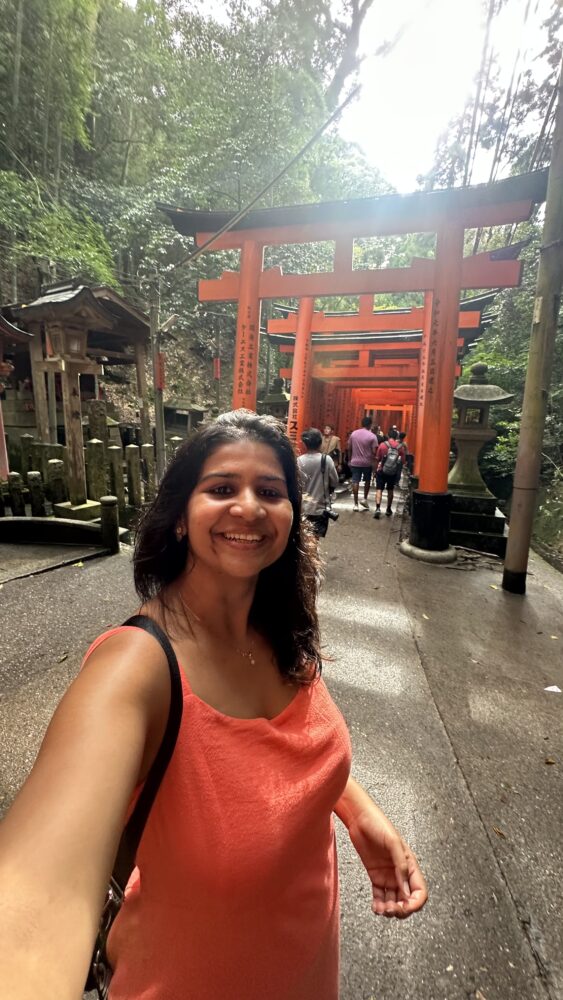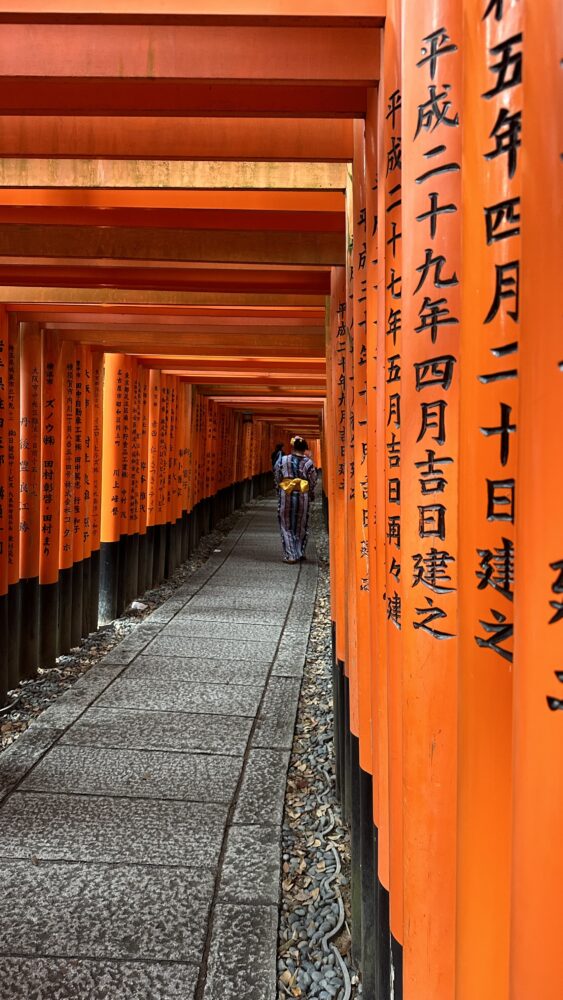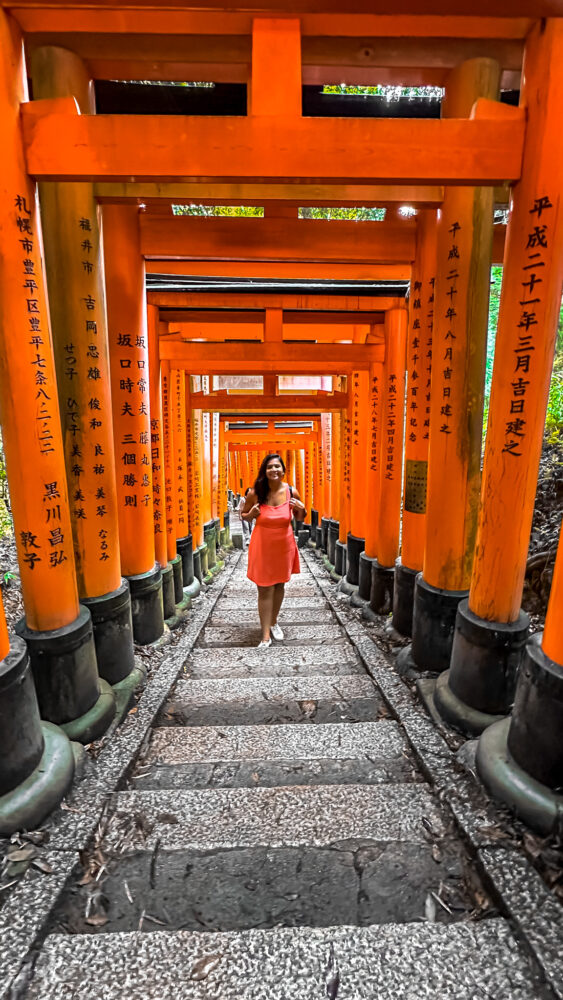Fushimi Inari guide
Fushimi Inari Shrine, known as Fushimi Inari Taisha in Japanese, stands as a significant Shinto sanctuary in Japan, venerating Inari, the deity of rice. Situated in the southern part of Kyoto at the foot of Mount Inari, it’s among the country’s most frequented landmarks.The shrine is renowned for its iconic thousands of torii gates, creating a network of pilgrimage paths up Mount Inari. The ascent to the mountain’s peak, which rises to 765 feet, typically requires a 2-3 hour hike over a distance of about 2.5 miles. As you journey along this path, you’ll come across numerous smaller shrines, charming teahouses, and places to rest, adorned with numerous kitsune (fox) statues.
Visiting the Fushimi Inari Shrine is a must-do when you’re in Kyoto. This ancient and significant shrine, with its earliest structures dating back to 711, offers a deep dive into Japan’s spiritual heritage. Exploring Fushimi Inari Shrine is not just a journey through a beautiful and historic site, but also an opportunity to immerse yourself in the captivating spiritual atmosphere of Japan. The Fushimi Inari Shrine holds the distinction of being the foremost Shinto shrine in Japan. Its historical roots stretch back to 711 AD, when it was established on Inariyama hill during the Nara period. The shrine’s inception is marked specifically on the first Horse Day of February in that year, signifying its long-standing significance in Japanese history and culture.
Throughout the years, Fushimi Inari Shrine has undergone significant evolution and growth in stature. In 816 AD, it was moved to its current site. Among the more than 32,000 Shinto shrines dedicated to Inari across Japan, Fushimi Inari stands out, particularly for its Senbon Torii, also known as the “Thousands Torii Gate”. This remarkable feature consists of over 10,000 vibrant vermilion gates, set closely together to form a visually striking tunnel effect along the stone-paved path leading up Mount Inari.
Best time to visit Fushimi Inari
Fushimi Inari Shrine is a highly popular destination in Japan, often drawing large crowds. Based on observations, the optimal times to explore Fushimi Inari Shrine with fewer people around are early in the morning or late in the evening. The site tends to become crowded after 10 am, reaching peak congestion around lunchtime. The timing of your visit plays a crucial role too. For instance, the shrine is particularly bustling during the cherry blossom festival. A visit towards the end of November or the beginning of December is recommended for those who wish to enjoy the splendid autumn foliage in a less crowded setting.
Throughout the year, Fushimi Inari Shrine is also the venue for various cultural festivals and events. These occasions are a celebration of traditional customs, featuring unique performances and local art and crafts. Visitors are encouraged to check the shrine’s official website or local event schedules to align their visits with these special events and fully immerse themselves in the cultural experience.
Fushimi Inari in the morning


Visitors to Fushimi Inari Shrine are recommended to start their journey early, ideally around 7 am or no later than 8 am, to avoid the crowds that gather by 10 am. Those who arrive around 7 am often find the shrine relatively quiet, offering a peaceful hike and ample opportunities for photography without the usual throngs of people. This early start allows for an almost solitary experience on the path to the mountain’s summit, with many smaller shrines along the way that can be enjoyed in tranquility.
It’s important to note that dawn in Kyoto varies, occurring between 4 am during the summer solstice and 6:30 am in the winter solstice. This means that an early morning hike around 7 am will be well-lit, and depending on the time of year, visitors might even witness a stunning sunrise.
For those planning a summer visit, the cooler morning temperatures provide a more comfortable hiking environment. Conversely, in winter, the mornings are colder and crisper, and extra caution should be taken on the trail to avoid slippery or icy conditions.
Fushimi Inari during sunset
Visiting Fushimi Inari Shrine during sunset offers a uniquely beautiful experience, though it’s worth noting that this time often attracts more visitors, making the trail busier. For those who don’t mind the presence of others, sunset provides an excellent opportunity for photography. Visitors aiming to capture this moment should plan their ascent to coincide with sunset, aiming to arrive at the Yotsutsuji intersection, located about halfway up the mountain, just in time.
At Yotsutsuji, one can enjoy breathtaking views of Kyoto. It’s an ideal location to witness and photograph the sunset at Fushimi Inari, adding a memorable and picturesque element to the visit.
Fushimi Inari at night
A visit to Fushimi Inari Shrine during the night offers a unique and enchanting experience. Since the shrine is open around the clock, exploring it after dark is a feasible option. The path to Mount Inari, lined with the iconic vermilion torii gates, takes on a mystical ambiance in the dim evening light. Adding to the atmosphere, traditional Japanese lanterns are spaced along the path, providing a gentle guide through the shrine grounds and beneath the torii gates in the quiet of the night. Although the shrine is generally considered safe, visitors are advised to stick to the designated trails and remain alert to their surroundings during their nocturnal exploration.
Getting to Fsuhimi Inari
To visit the Fushimi Inari Shrine from Kyoto, there are two convenient train options:
Firstly, if you have a JR Pass, the JR Nara Line is ideal. You’ll start your journey at Kyoto Station and board a train on the JR Nara Line. It’s a brief 5-minute ride to Inari Station, which is the stop you’ll get off at.
Alternatively, for those with a Kansai Thru Pass, the Keihan Main Line is a great choice. Begin at Kyoto Station, then transfer to a train on the Keihan Main Line heading towards Fushimi-Inari Station. Once you exit Fushimi-Inari Station, the shrine is just a short walk away.
What are the Torii gates at Fushimi Inari shrine?
The torii gates lining the path at Fushimi Inari Shrine have a unique history, as they’ve been donated by various Japanese businesses wishing for prosperity. This tradition of donating torii gates dates back to the Edo period. Inscriptions found on the back of these gates, visible when descending from the mountain towards the main gate, bear the names of the donors. The cost of donating a torii gate ranges significantly, from around 400,000 yen for smaller ones to over 1,000,000 yen for larger gates.
Torii gates are traditionally seen as the threshold between the physical and spiritual realms. The Senbon Torii at Fushimi Inari are painted in a striking vermilion red, known as shuiiro in Japanese. Vermilion is a color believed to ward off evil and bad luck in Japan. The paint used on these wooden gates is a special concoction of mercury and red earth, a practice that has been followed since ancient times. This particular mixture not only imparts the vibrant color but also helps protect the gates from weathering and insect damage.
What are the fox statue at Fushimi Inari shrine ?
Throughout the pathways of Fushimi Inari Shrine, visitors will encounter numerous kitsune (fox) statues, revered as messengers of the deity Inari. Contrary to some beliefs that these fox statues represent Inari itself, Inari scholar Karen A. Smyers clarifies in her book “My Own Inari: Personalization of the Deity in Inari Worship” that Shinto and Buddhist teachings distinguish Inari and the foxes as separate entities. Many of these fox statues are adorned with red yodarekake (votive bibs), believed to protect against demons and illness, symbolizing the kitsune’s dedication to Inari.
A closer inspection of these statues reveals that they often hold symbolic objects, like a key (representing the key to a rice granary), a sheaf of rice, or a jewel. An intriguing aspect of some kitsune statues at the shrine is their multiple tails. These tails are indicative of their wisdom, age, and power, with a greater number of tails signifying a fox of higher potency and venerability.
Food and souvenirs
At Fushimi Inari Taisha, street food enthusiasts will be delighted by the array of tasty options. One can savor Hashimaki Okinomiyaki, a type of savory Japanese pancake served on a stick. For those seeking heartier fare, yakisoba stir-fry and prawn rice crackers with egg are popular choices. Personal favorites among many include grilled salted fish and squid skewers served on sticks. For dessert, there’s a variety of choices like custard creams, red bean pancakes, and the particularly favored sweet potato fries.
For a more relaxed dining experience, several cafés and restaurants in the vicinity offer delicious and budget-friendly meals. Noteworthy among them are Vermillion Cafe, Inarinadai Dohachi known for its Udon, and Kyoto Shoryu, a spot for tasty ramen. A must-try is the Kitsune Udon, a noodle soup with seasoned fried tofu in a dashi broth, garnished with pink-swirl narutomaki fish cake.
After completing the hike, visitors often look forward to taking home a memorable souvenir. Popular choices include a small ema torii prayer plaque or an omamori, a traditional Japanese shrine charm, available at the main Fushimi Inari Taisha complex. Some visitors cherish these souvenirs, like the torii-shaped ema, which often finds a special place in their homes.
Beyond the allure of Fushimi Inari Shrine, the surrounding area in Kyoto is rich with other attractions worth exploring. These include the tranquil Arashiyama Bamboo Forest, the historic Gion district, and the iconic Kiyomizu-dera Temple, all adding to the enriching experience of visiting Kyoto.
Tips for visiting to Fushimi Inari shrine
A visit to Fushimi Inari Shrine can be a deeply fulfilling experience when approached with the right preparation, as gleaned from multiple personal visits. Here are some insights:
- Early Morning Visit: To truly appreciate the shrine’s ambiance, an early morning visit is recommended. This timing is ideal for avoiding large crowds and coincides with the opening of food stalls, perfect for a post-hike treat.
- Appropriate Footwear: Based on experience, wearing comfortable shoes is crucial. While some might start off with casual footwear like Converse, it’s found that running shoes, such as those from New Balance, are more suitable for the uneven and occasionally slippery paths, particularly on rainy days.
- Weather Readiness: It’s best to choose a dry day for the hike. In case of rain, having a waterproof coat with a substantial hood is essential to remain dry and comfortable.
- Light Travel: It’s advised to travel light, avoiding heavy backpacks or suitcases. The shrine’s path includes numerous stairs, and while the hike is manageable for most fitness levels, carrying a heavy load can be cumbersome and tiring.
- Photography Opportunities: For photography enthusiasts, the areas beyond the main gate are less crowded, offering better opportunities for uninterrupted shots. A detailed photographic guide to Fushimi Inari Shrine can be especially useful for those keen on capturing its beauty.
Respecting Local Culture: Since Fushimi Inari is a sacred site, showing respect is paramount. Those unfamiliar with local customs should consider researching basic etiquette and practices to ensure a respectful visit to this spiritual location.







